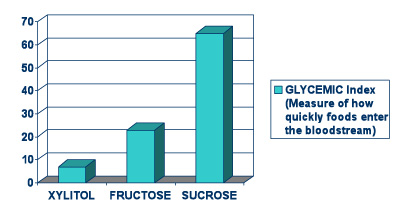
INTRODUCTION
The USDA statistics show consumption of sugar to be about 20 teaspoons (0.42 cups) per person per-day, and that's only what is added to food and drink — not the sugar occurring naturally in food. Sucrose (table sugar) remained the sugar of choice even after the introduction of artificial sweeteners. Increases of blood glucose, serum lipids and insulin have been associated with sugar consumption.
Xylitol is the alcohol form of xylose, which is a natural sugar. Xylitol derives its name from xylan, meaning wood, and is manufactured from natural xylan-rich sources (biomass) such as birch tree bark, and corn fiber. Wood sugar (xylose) is extracted from the biomass, and the liquid wood sugar is then converted to pure crystalline xylitol.
The leading cause of caries is the production of plague on tooth surfaces by oral bacteria like Streptococcus mutans which in turn converts to acid that eats through the enamel. However, these bacteria can not ferment xylitol due to its unique 5-carbon structure, and therefore cannot be converted to harmful acids.

Caries is a transmissible bacterial infection. Xylitol interferes with adherence of Streptococcus mutans and hence transmission. It inhibits the transfer of bacteria from person to person by altering the way the bacteria stick to surfaces as well as plaque and dental cavities by 80%. Use of xylitol gum by mothers reduced colonization in infants even better than chlorhexidine. 1
A 6-year study in Finland has shown that habitual xylitol consumption of mothers was associated with a statistically significant reduction in the probability of mother-child transmission of mutans streptococci (MS) assessed at 2 years of age. Subsequent study demonstrated xylitol-associated reduction in the probability of mother-child transmission of MS was still found in the children's MS counts at the age of 3 and 6 years. 2
Figure below shows incidents of caries and the effect of chewing xylitol gum. 4

ADVANTAGES OF XYLITOL
Xylitol binds with calcium and other polyvalent cations, contributing to remineralization of enamel. The calcium-xylitol complexes facilitate calcium absorption through the gut wall. This suggests xylitol may play a role in preventing osteoporosis. This hypothesis has been tested in experimental animals. The effect was achieved when using xylitol concentrations of 10 and 20%, but not when using a 5% concentration. 3
Below are other advantages of using xylitol on a regular basis using the recommended doses:
• Improves breath odor
• Relieves 'dry mouth'
• Reduces infections in the mouth and nasopharynx.
• May help prevent sinus infections, bronchitis and pneumonia according to research.
• Xylitol seems to have a preventive effect against acute otitis media. (7)
Products Made with Xylitol
• Xylitol in crystallized form.
• Gums
• Mints
• Crystals
• Nasal Sprays
• Throat lozenges
• Jams
• Vitamins in spray form
Side Effects of Xylitol
Xylitol may be safely used in foods for special dietary uses, provided the amount used is not greater than that required to produce its intended effect.5 Consumption of xylitol in high amounts may have laxative effects on some individuals, however this effect is usually transient. Up to 80 grams of xylitol have been proven to be well tolerated by middle-aged women. 3
Disadvantage of Xylitol
Artificial sugar substitutes have 0 calories, whereas Xylitol has 40% less calories than table sugar. Excessive consumption due to its medicinal and dietary characteristics is anticipated and therefore, can become a disadvantage.
The graph below is a representation of Glycemic Index (GI) comparison of xylitol, fructose and sucrose. GI is a measure of how quickly foods enter the bloodstream.

Conclusion
Prevention is the most desirable treatment of any disease. It is the most feasible solution, both physically and economically. Xylitol can be a very effective preventive measure of many diseases that originate in mouth, especially dental caries. Unfortunately, xylitol and products made with it are not yet available in the market as readily as sugar or other substitute sugars and the cost to the consumers are higher as well.
REFERENCES
• J. Dent. Res. 79:882-887, 2000
• PMID: 11385196 [PubMed - indexed for MEDLINE]
• Pauli Mattila, Institute of Dentistry, University of Oulu, ISBN 951-42-5158-X; URN:ISBN:951425158X
• Isokangas P. Alanen P. Tiekso J, Makinen K.K. Xylitol chewing gum in cavity prevention. A field study in children at caries-active ages. J Am Dent Assoc 1988
• Chapter I--Food and Drug Administration, Department of Health and Human Services; [CITE: 21CFR172.395]
Author: Hengameh Yousefzadeh
Title: Review Research on Xylitol and Its’ Role in Preventive Dentistry
ABSTRACT:
Caries is a transmissible bacterial infection which can be prevented by xylitol, a natural sugar. Xylitol is not fermented by Streptococcus Mutans and therefore can not be converted to harmful acids. Use of xylitol gum by mothers reduces colonization in infants even better than chlorhexidine. Chewing 6 grams to 9 grams of xylitol gum has been shown to have meaningful reduction in tooth decay, especially if taken after each meal. Xylitol with concentration of 10% to 20% may play a role in preventing osteoporosis. Xylitol can also help prevent acute otitis media. Consumption in high amount initially may cause diarrhea, however this effect is only temporary. Excessive consumption due to its medicinal and dietary characteristics is anticipated and therefore, can become a disadvantage.